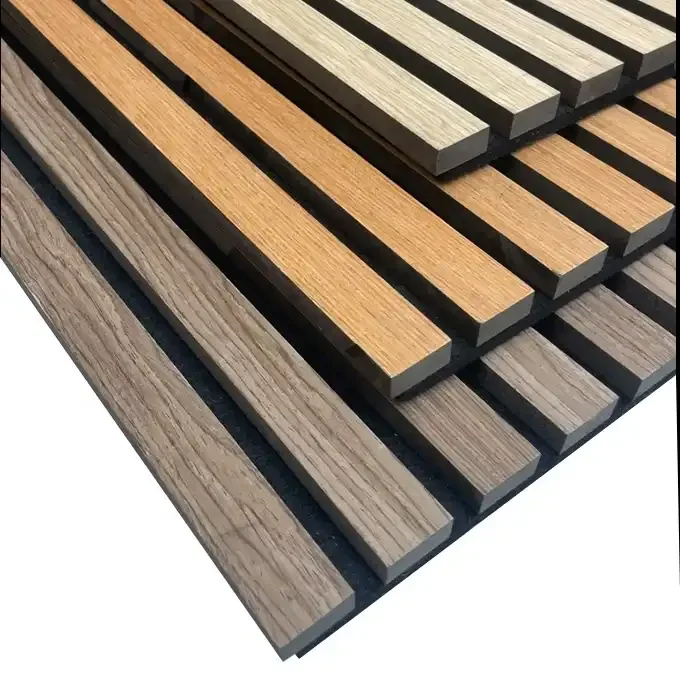Sound-absorbing panels are a material commonly used to improve audio environments. They can effectively absorb noise and reduce echoes. The following is an introduction to some common sound-absorbing panel materials:

Synthetic cellulose material: Synthetic cellulose is one of the common materials in sound-absorbing panels. It is lightweight, soft and has good sound absorption effect. Common synthetic cellulosic materials include acoustic wool, polyacetate, and polyester. They can effectively absorb sound waves and reduce noise and echo through their porous structure and the sound-absorbing properties of the material itself.
Foam plastic: Foam plastic is also a common sound-absorbing panel material. It has good sound absorption properties and sound insulation effect. Common foam plastics include polyethylene foam, polyurethane foam, and polystyrene foam. The porous structure of foam effectively disperses sound waves and absorbs them.
Mineral wool board: Mineral wool board is a sound-absorbing material made from asbestos. Due to the fibrous structure of asbestos itself, mineral wool panels have excellent sound absorption and sound insulation properties. It not only has good sound-absorbing properties, but can also inhibit the propagation of sound waves and achieve noise reduction effects.

Wood Materials: Wood materials are often used in acoustic panels where designers or audio professionals are concerned with appearance. Compared with other materials, wood has advantages in appearance and decorative properties. Wooden materials absorb sound through their density and structure, reducing noise and echoes.
Polyester fiberboard: Polyester fiberboard is a processed fiber material that has good sound-absorbing properties and durability. It is commonly used in cinemas, audio rooms and recording studios where advanced acoustic performance is required. Polyester fiberboard not only absorbs high-frequency sound waves, but also reduces low-frequency noise.
Perlite Board: Perlite Board is a natural mineral material formed by volcanic eruptions. It has the characteristics of low density, low sound conduction coefficient and good sound absorption effect. Perlite boards are usually used in noisy places such as factories, computer rooms, and gymnasiums to reduce noise and improve sound quality.
Metal sound-absorbing panels: Metal sound-absorbing panels are usually made of aluminum or steel and have good durability and fire resistance. This type of sound-absorbing panels is commonly used in commercial buildings, offices, conference rooms, etc., and can effectively absorb sound and reduce noise.
Plywood: Plywood is a material made of multiple layers of staggered wooden veneers that are glued and reinforced. It has good sound absorption and insulation properties, as well as strength and stability. Plywood is commonly used in architecture and interior design to improve the acoustic environment without affecting the structure.
To summarize, material selection for acoustic panels depends on specific application needs, budget, and personal preference. Choosing appropriate sound-absorbing materials can effectively improve the indoor acoustic environment, reduce noise and echo, and provide a better listening experience.

Sound-absorbing panels are an acoustic material widely used in various places. Its main function is to absorb noise and reduce echoes, thereby improving the audio environment. The following is an introduction to the application of sound-absorbing panels in different fields:
Audio-visual rooms: In audio-visual rooms, sound-absorbing panels are widely used on surfaces such as walls, ceilings, and floors to reduce sound reflections and echoes. This improves the acoustics, making the audio clearer and free from background noise, allowing viewers to enjoy a better audio-visual experience.
Audio recording studios: In audio recording studios, sound-absorbing panels are used to control echo and reverberation within the room, thereby maintaining the sound quality and accuracy of the recording. They are usually installed on walls, ceilings and floors to ensure that the audio signal is free from excessive reflections and interference during the recording process.
Conference rooms and multi-purpose halls: In order to keep the sound of meetings and lectures clear and audible, sound-absorbing panels are often used in conference rooms and multi-purpose halls. They are installed on walls, ceilings and floors to reduce sound echo and ensure that participants can clearly hear speakers, improving communication.
Restaurants and cafes: In social spaces such as restaurants and cafes, acoustic panels can reduce the impact of loud and ambient noise, providing a better dining and conversation experience. By installing sound-absorbing panels on walls, ceilings and floors, you can effectively reduce the reflection and spread of sound, creating a comfortable and peaceful environment.
Offices and commercial spaces: Acoustic panels can also be used in offices and commercial spaces to reduce noise and improve the comfort of the working environment. By installing sound-absorbing panels, you can reduce noise from various sources, such as keyboard tapping, phone ringing, and office equipment, thereby improving employee concentration and productivity.

In general, sound-absorbing panels play an important role in various fields, improving the acoustic environment, enhancing the listening experience, and protecting health. Whether in entertainment venues, audio recording studios, commercial spaces or personal residences, sound-absorbing panels can create a better acoustic environment, allowing people to enjoy a clearer and more comfortable sound experience.


